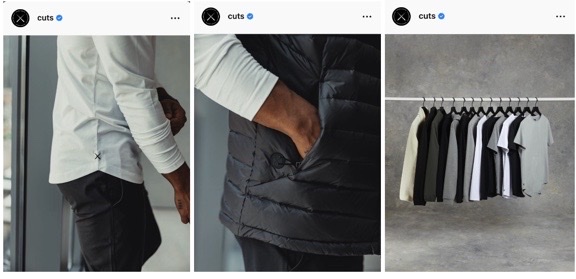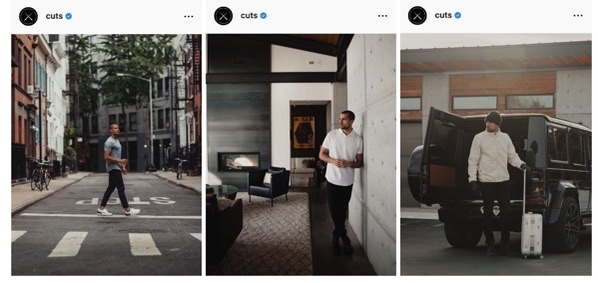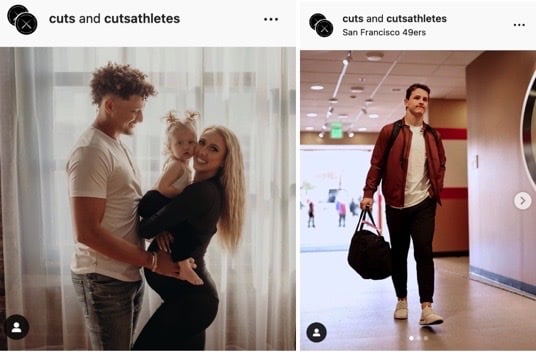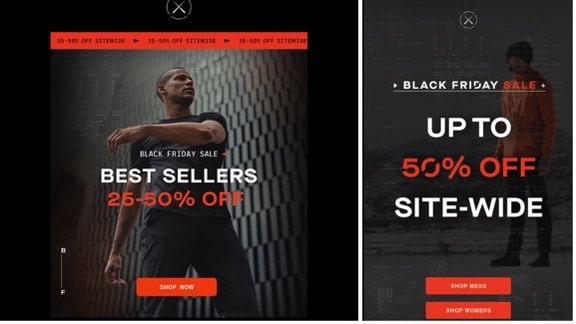Move over, business casual — there’s a new trend in town, and it’s called athleisure. With this trend, we’re ditching the restrictive suits and painstaking heels for stretchy, breathable fabrics and sneakers. As athleisure brands blow up in the post-pandemic fashion era, it’s hard not to be lured to brands like Lululemon, Athleta, Alo Yoga, and Vuori who are aggressively scooping up market share in this category.
Whether it’s through their social media content, their television commercials, or point-of-sale displays at brick and mortar retailers, these direct-to-consumer (DTC) ecommerce brands are attracting and engaging an audience who is clamoring for comfort and convenience.
In this article, we will look at a specific lifestyle brand I’ve had my eye on for the last year — Cuts, an athleisure clothing brand whose mission is to “inspire those to compete and win in the Sport of Business.” We will discuss how Cuts is using organic and paid social media marketing, as well as Google Ads, to drive revenue growth and customer acquisition for the brand.
More specifically, I will share my personal experience with Cuts from brand awareness, to purchase, to becoming a brand fan. I’m curious if their marketing attrition model attributes my purchase to the right channel(s), and if it is sophisticated enough to realize that not all credit goes to the Google Ads. @Cuts, we invite your response!
Creating Brand Awareness for Cuts Clothing
I was first introduced to Cuts by Dani Austin who is presumably a paid influencer for the brand or uses their affiliate marketing program to create and publish content on her Instagram page featuring her husband Jordan wearing Cuts shirts and pants.
Dani and Jordan’s endorsement for the brand describes the buttery soft material and how perfectly the t-shirt fits. I was quick to give credibility to the quality of the brand, as I’ve followed Dani for years and trust her product recommendations.
I likely clicked through to visit the Cuts website (one of my many visits to the site before actually making a purchase) and at some point early in my journey, I subscribed to their emails.
Through Dani, I became aware of the brand, gave it some favor, and was mostly curious to learn more and potentially purchase for my son and/or husband. Over the following months I discovered more and more influencers promoting the brand, proving that influencer marketing is at the helm of Cuts’ customer acquisition approach.
Fostering Engagement for Cuts Clothing
Throughout the next year, I observed how Cuts’ social media altogether is an integral part of their customer acquisition strategy, and for good reason. It allows businesses to reach and engage with their target audience in a way that is both personal and cost-effective.
As I talk regularly with DTC marketers, some are struggling knowing how to attribute ROI to social media. While the content is seen by thousands and even millions of users across platforms, it may not drive to immediate revenue. It’s important to understand the role that social media plays in modern marketing, and my personal path to purchase with Cuts is a good illustration of this.
Cuts uses a wide variety of content types in their social media including product-focused photography such as these posts:

They also use lifestyle photography like these:

Videos is another engaging type of content Cuts uses regularly on social media. They mix several styles of video content such as high(er) production videos like this one, simple engaging animations like this, and raw low production videos. They also integrate video about the company such as this one with founder Steven Borrelli.
Cuts leverages a variety of marketing tactics to feed their social media including paid influencers, affiliate marketing programs, user generated content, and Cuts works with athletes including guys like Patrick Mahomes and Brock Purdy to rep their brand.
Throughout my personal Cuts journey, I observed or engaged with the brand on social media nearly daily, and opened their emails many times, often visiting the website to shop around. During this time I developed an affinity to Cuts well before ever making a purchase. I started talking about the brand with friends and family, inquiring who has purchased and sharing my desire to buy.
Converting to a Cuts Customer
In addition to social media, Cuts also utilizes Google Ads to drive traffic to its website and increase conversions. By targeting specific keywords and demographics, the company reaches a wider audience and drives qualified traffic to its site.
As Christmas 2022 drew near, I was confident that I wanted to purchase Cuts for my husband and son. Leading up to Black Friday, Cuts launched their Black Friday campaign with a black and red creative design. The company’s emails, social media posts, and ads all reflected this cohesive campaign which worked effectively to drive consumers to purchase with a promotional discount, although I would have purchased with or without the promotion.
What Channels Deserve Credit for My Cuts Purchase?
The irony of my journey is that social media was the primary channel to introduce me to the brand, educate me on Cuts and its products, and ultimately created my desire to purchase and to splurge in spending a premium amount on t-shirts and sweatpants.
However, guess what I did when I was ready to buy?
I went to Google, searched for “Cuts Clothing”, clicked the Google Ad that displayed at the top of the page, and purchased.
Many marketing tracking tools would attribute credit of my purchase to Google Ads, the last touch that garnered the purchase, and social media would get little to no credit from a data perspective.
But that’s not accurate.
I attribute the majority of credit to Cuts’ social media, supported by influencer and email marketing, and finally topped off by Google Ads and a good website experience.
What’s more, the product really is as good as I hoped. The material is buttery soft, stretchy, fits perfectly and is washing well.
5 Key Takeaways
Looking at Cuts as a model for inspiration, a few key takeaways we can learn from this are:
- Be mindful of how you measure customer attribution and revenue by channel.
- DTC consumer brands should use both organic and paid social strategies.
- Don’t underestimate the power influencer marketing has on brand awareness and credibility.
- Use a mix of quality content in your marketing. Video, photography, graphics, animations, and user-generated content all have a role in a strong content strategy.
- Lean into modern marketing and recognize that consumers are inundated with content, so staying present across multiple channels is not only important, but necessary for success.




